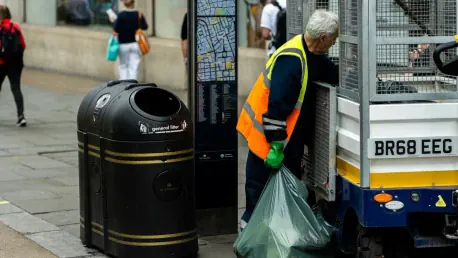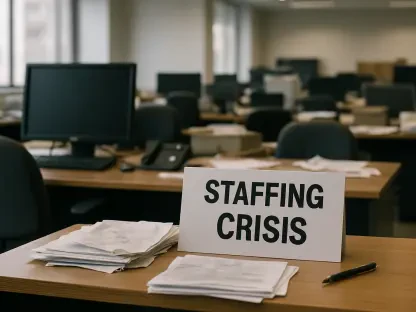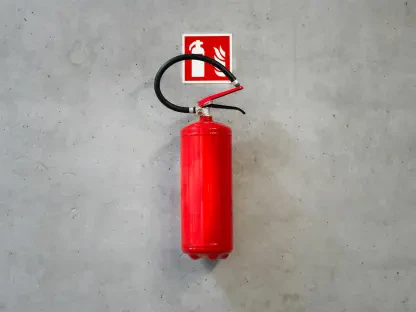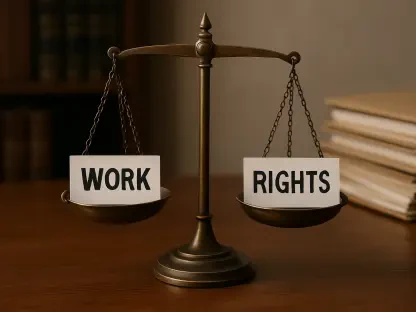Wildfires have become an increasingly common and devastating occurrence, particularly in regions like Los Angeles. The aftermath of these fires leaves behind a trail of destruction that requires extensive cleanup efforts before any reconstruction can begin. This critical work often falls on the shoulders of immigrant workers, who face numerous risks and challenges in the process.
The Essential Role of Cleanup Workers
The Necessity of Post-Fire Cleanup
The debris and ash left behind by wildfires pose significant hazards and must be cleared to pave the way for rebuilding. This cleanup process is not only labor-intensive but also fraught with dangers, including exposure to toxic substances and unstable structures. The urgency of these efforts cannot be overstated, as delays in cleanup can hinder the overall recovery and reconstruction process. In addition to immediate physical hazards, there is a pressing need to remove debris that could pose long-term health risks if left unattended. This necessitates a timely and thorough cleanup to establish safer living conditions for returning residents.
An immediate hazard is the unstable structures left charred and weakened by fire, posing an imminent risk of collapse during cleanup operations. Furthermore, the residue left behind is often laced with toxic chemicals from household products, building materials, and vegetation burned in the fire. When these substances become airborne, they can be inhaled by cleanup workers, leading to severe respiratory issues. All of these factors underscore the demanding and hazardous nature of post-wildfire cleanup operations and the critical need for these tasks to be handled with great caution and urgency.
Immigrant Workers: The Backbone of Cleanup Efforts
Immigrant workers play a crucial role in these cleanup operations. Many of them turn to this work after losing their previous jobs due to the fires. Their willingness to take on these perilous tasks is driven by necessity, as they often have limited employment options. Despite their critical contributions, these workers frequently face inadequate protection and support. They often lack access to proper protective gear and are not provided with adequate safety training, making them vulnerable to the myriad risks associated with this dangerous work.
The immigrant workforce in post-wildfire cleanup is primarily composed of individuals from industries that were also severely impacted by the fires, such as agriculture and service sectors. Many of these workers have families dependent on their income, creating a dire need for immediate employment, even if it means undertaking hazardous tasks. Unfortunately, these workers often fall through the cracks of regulatory protections, finding themselves without adequate recourse for unsafe working conditions. The contributions of these workers are indispensable, yet their safety and well-being are frequently overlooked in the rush to achieve swift community recovery.
Health and Safety Risks
Exposure to Toxic Substances
One of the most significant dangers faced by cleanup workers is exposure to toxic substances. The ash and debris left behind by wildfires can contain harmful chemicals and pollutants, posing serious health risks. Workers often lack proper protective gear, increasing their vulnerability to respiratory issues and other health problems. The presence of heavy metals, asbestos, and other hazardous materials within the debris significantly exacerbates these risks, making it crucial for workers to have access to comprehensive protective measures.
When inhaled or coming into contact with bare skin, these toxic substances can lead to acute and chronic health issues, ranging from skin irritations to more severe long-term conditions such as lung disease or cancer. The dangers are not immediately apparent but accumulate over time, making continuous exposure particularly detrimental. Despite the well-documented health hazards associated with these toxic substances, the enforcement of protective regulations remains inconsistent, often leaving immigrant workers inadequately safeguarded against these silent yet potent threats.
Physical Hazards and Long-Term Health Impacts
In addition to toxic exposure, cleanup workers are at risk of physical injuries from unstable structures and debris. The long-term health impacts of this work are a growing concern, with many workers experiencing chronic health issues as a result of their exposure to hazardous conditions. The lack of adequate safety measures exacerbates these risks. Common injuries include cuts, fractures, and musculoskeletal injuries caused by lifting heavy debris or working in precarious environments. Continuous exposure to such dangerous conditions without proper safeguards can lead to debilitating and long-lasting health problems.
The immediate physical hazards are compounded by the stressful and demanding nature of the work, which often requires long hours in harsh conditions. This relentless physical strain, combined with the lack of protective gear, means even minor injuries can escalate into severe health issues over time. Moreover, many workers do not have access to adequate healthcare services, making it difficult to address and manage these injuries promptly. The psychological toll of working in such perilous conditions, coupled with the uncertainty of their employment status and the health risks, further exacerbates the long-term impacts on the well-being of these essential workers.
Regulatory and Advocacy Efforts
Existing Safety Regulations
State regulations mandate certain safety measures for workers involved in hazardous cleanup operations. However, the chaotic environment following a disaster often leads to gaps in enforcement. This discrepancy between regulations and actual working conditions leaves many workers unprotected and vulnerable. In theory, these regulations should provide comprehensive protection, requiring the provision of protective equipment and adherence to safety protocols. In practice, these standards are rarely met, particularly in the aftermath of a wildfire when the priority is on speed rather than compliance.
The enforcement mechanisms for these regulations often fall short, overwhelmed by the sheer scale of destruction and the urgency of the cleanup process. Regulatory agencies may lack the resources or personnel to effectively monitor and enforce compliance, leaving many workers to fend for themselves. Additionally, many immigrant workers may be unaware of their rights and the protections to which they are entitled, further complicating enforcement efforts. This gap between regulation and reality underscores the need for more robust and proactive measures to ensure the safety of workers on the ground.
The Role of Advocacy Groups
Worker advocacy groups are actively working to bridge these gaps by providing training, protective equipment, and educational outreach. These organizations strive to ensure that workers are aware of the risks and equipped to mitigate them. Despite these efforts, challenges in enforcement and resource allocation persist. Advocacy groups often face an uphill battle, contending with limited funding and competing priorities. Nonetheless, their work is invaluable in raising awareness, advocating for policy changes, and directly supporting workers in need.
These groups also play a critical role in gathering and disseminating information about the specific hazards faced by cleanup workers, helping to highlight areas where regulatory protections are falling short. By organizing training sessions and distributing protective gear, they aim to reduce the immediate risks faced by workers. Moreover, they provide crucial legal and logistical support to workers, helping them navigate complex regulatory landscapes and access the resources they need. Despite these challenges, the persistent efforts of advocacy groups demonstrate the importance of community-based initiatives in enhancing worker safety and ensuring their voices are heard.
Training and Equipment
Training Programs for Safety Protocols
Some organizations have initiated training programs to educate workers on safety protocols and the proper handling of hazardous materials. These programs aim to reduce the risks associated with cleanup work by ensuring that workers are knowledgeable and prepared. Training sessions cover a range of topics, from the correct use of protective gear to identifying and mitigating specific hazards present in the debris. By equipping workers with the necessary skills and knowledge, these programs help create a safer working environment and reduce the incidence of injury and illness.
Effective training programs also emphasize the importance of personal protective equipment (PPE) and proper hygiene practices to minimize exposure to toxic substances. They provide hands-on demonstrations and practical guidance, ensuring that workers understand how to apply these principles in real-world scenarios. However, the success of these programs depends on their accessibility and frequency, as well as the ongoing support and reinforcement of safety practices. Consistent and comprehensive training is essential to maintaining a high standard of worker safety in the unpredictable and hazardous conditions of post-wildfire cleanup operations.
Distribution of Protective Gear
In addition to training, advocacy groups and some employers are distributing protective gear to workers. This equipment is essential for safeguarding workers against the numerous hazards they face. However, the availability and quality of this gear can vary, leaving some workers inadequately protected. High-quality PPE, including respirators, gloves, and protective clothing, is crucial for minimizing exposure to toxic substances and physical injuries. The distribution of such equipment should be standardized and consistent to ensure all workers have access to the protection they need.
Challenges in the distribution of protective gear often stem from logistical issues and resource constraints. While advocacy groups and responsible employers strive to provide adequate equipment, the demand frequently outstrips supply, and not all workers receive the necessary gear. Furthermore, regular maintenance and timely replacement of PPE are critical to its effectiveness, yet these aspects are often overlooked. Addressing these challenges requires a coordinated effort to secure sufficient resources and streamline distribution processes, ensuring all workers are equipped to carry out their tasks safely and effectively.
The Vulnerability of Immigrant Workers
Employment Challenges and Risks
Immigrant workers often find themselves in precarious employment situations, particularly in the aftermath of a disaster. Many lack proper documentation or state-required certifications, making them more susceptible to exploitation and hazardous working conditions. Their vulnerability is compounded by language barriers and limited access to resources. These factors create a challenging environment where immigrant workers must navigate complex circumstances to secure and maintain employment, often at the expense of their health and safety.
The precarious employment situations faced by immigrant workers are exacerbated by the informal nature of the cleanup work. Many jobs are offered on a temporary or cash basis, leaving workers without the legal protections and benefits afforded to formal employees. This lack of job security and official recognition makes it difficult for workers to advocate for better conditions or report unsafe practices. Additionally, fear of deportation or legal repercussions further deters many from speaking out, trapping them in a cycle of hazardous and insecure employment. Addressing these issues requires targeted policy interventions and support mechanisms to protect these vulnerable workers and ensure they have access to safe, fair employment opportunities.
Efforts to Support Immigrant Workers
Despite these challenges, there are ongoing efforts to support immigrant workers in the cleanup industry. Advocacy groups are working to provide legal assistance, language support, and access to resources. These initiatives aim to empower workers and improve their safety and working conditions. By offering legal aid, these organizations help workers navigate issues such as wage theft, unfair dismissals, and unsafe working conditions. Language support services are crucial for reducing communication barriers, allowing workers to understand safety protocols and their rights more effectively.
Community-based programs also focus on providing essential resources such as food, housing, and healthcare, which can alleviate some of the immediate pressures faced by immigrant workers. These efforts create a network of support that helps workers feel more secure and valued in their roles. Furthermore, advocacy for policy changes at local and state levels aims to strengthen protections for immigrant workers and ensure their rights are upheld. By fostering a supportive environment, these initiatives contribute to creating safer, more equitable conditions for all workers involved in post-wildfire cleanup efforts.
The Future of Post-Wildfire Cleanup
The Growing Need for Cleanup Workers
As wildfires become more frequent and destructive, the demand for cleanup workers is expected to rise. This growing need underscores the importance of addressing the safety and well-being of these workers. Ensuring that they are adequately protected and supported is crucial for the success of recovery efforts. A comprehensive approach that combines improved regulatory enforcement, robust training programs, and accessible protective equipment is essential to meet the increasing demands of post-wildfire cleanup operations.
The scale and frequency of wildfires are projected to grow, driven by factors such as climate change and urban expansion into fire-prone areas. This escalation in wildfire activity means that more communities will require extensive cleanup and recovery operations, relying heavily on a workforce that must be adequately prepared and protected. The safety and well-being of cleanup workers should be central to disaster preparedness and response planning, with measures in place to ensure their health and safety are not compromised in the rush to restore affected areas.
Improving Safety and Working Conditions
Wildfires have increasingly become a common and devastating event, particularly affecting regions such as Los Angeles. The aftermath of these fires is marked by extensive destruction that necessitates significant cleanup efforts before any rebuilding can commence. This vital work often falls to immigrant workers who face numerous risks and challenges as they carry out these cleanup operations.
These workers are crucial to restoring the devastated areas, removing debris, and preparing the land for reconstruction. Despite their essential role, they encounter substantial hazards, including exposure to toxic substances, unstable structures, and harsh working conditions. Moreover, many of these workers might lack adequate protective equipment and training, further amplifying the dangers they face on the job.
In addition to the physical risks, immigrant workers often deal with legal and financial challenges. Their immigration status may make them vulnerable to exploitation, with limited access to health care, fair wages, and job security. They may also struggle with language barriers and a lack of support systems, which can exacerbate the difficulties of their work.
The contributions of these workers are integral to the recovery process following wildfires. Yet, they frequently go unrecognized and unsupported, highlighting the need for better protections, training, and resources to ensure their safety and well-being as they carry out this critical, yet perilous, work.









